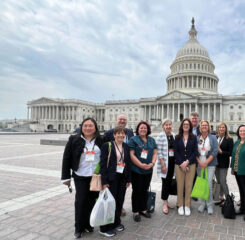Pandemic Makes Future-Proofing Technology Critical
Strategic planning that future-proofs technology, and nationwide broadband, are among current priorities for technology aging services, said Majd Alwan, Ph.D., CAST executive director and senior vice president of technology and business strategy at LeadingAge.
Alwan recently shared these and other technology-related thoughts in episode 5 of the Reach Radio podcast, “What Every Post-Acute Care Facility Should Know.”
Primary Pandemic Technologies
Technology is a must-have, especially in the COVID-19 age of resident lockdowns, when interest in and reliance on technology have risen significantly. Alwan discussed four technologies of particular importance in pandemic times:
- Social connectedness and engagement technologies that reduce social isolation.
- Telehealth services in skilled nursing and independent living facilities, to prevent the spread of the virus.
- Screening technologies for patients, residents, and guests and contact tracing technologies.
- Infection control technologies that disinfect personal devices and medical equipment and filter air. Emerging technologies now being deployed include using UV lights for disinfection and robots that spray disinfectants.
Industry Challenges
Alwan shared several challenges in the IT industry in the aging space and his hopes for improvement in the future.
- Baking Technology into Strategic Goals and Investments: It is critical to ensure that technology is ingrained in provider organizations’ strategic goals. Some aging organizations do not have a cohesive plan, which makes it harder to create interoperability.
- Investing in Future Technology: In pivoting quickly in response to the pandemic, some organizations found their infrastructure did not have sufficient bandwidth, capacity, staff training and comfort, support, capabilities, etc. Providers must future-proof their infrastructure. They must invest enough in preparing their infrastructure to support the applications they need today and tomorrow.
- Accessing Broadband Nationwide: The United States needs a more robust IP and ICT and broadband infrastructure to support these technology applications. It needs to be accessible everywhere. In rural areas, telemedicine and telehealth would be highly beneficial for older adults. In urban areas, social connectedness technologies and telehealth would help older adults who are homebound. Being able to afford internet connectivity is also a challenge for older adults.
CAST Technology Resources
Alwan discussed CAST’s focus on creating technology tools to support aging service providers nationwide, including smaller providers.
Strategic IT Planning Tools: These CAST tools can help organizations solve the challenges above. Plans and goals that are more than a couple years old are ready to make way for a new plan, as technology changes quickly and COVID has brought many new learnings.
CAST Technology Selection Tools: These eight portfolios help aging services providers to choose and implement the right tools to meet their organization’s needs. A portfolio on data analytics will be added in early 2021.
- EHR Technology Selection Tool
- Functional Assessment and Activity Monitoring Technology Selection Tool
- Health Information Exchange Technology Selection Tool
- Medication Management Selection Tool
- Safety Technology Selection Tool
- Shared Care Planning and Coordination Technology Selection Tool
- Social Connectedness and Engagement Technology Selection Tool
- Telehealth and RPM Selection Tool
What’s Needed to Succeed in Aging Services
Those thinking of going into the post-acute care market must have heart and a love of older adults, Alwan said. They should also have a deep understanding of the types of aging services, different operating and payment models, the regulatory landscape, and some of the challenges. Understanding the different technology categories that are needed and in demand is also key.
For more important insight, listen to the full podcast.

Most Recommended
February 29, 2024
Say Yes to Lobby Day!
April 05, 2024
Cyberattack Updates: Change Healthcare Payment Platform
March 27, 2024
 Colleagues on the Move, March 27, 2024
Colleagues on the Move, March 27, 2024
April 12, 2024
Improving Medicare Advantage
Recently Added
April 17, 2024



